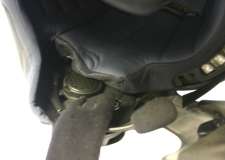A motorcycle police officer on an urgent call faces huge information processing and decision-making demands. A new European research project aims to prevent potentially dangerous information overload.
A motorcycle police officer on the roll could serve as a case study of the challenges of multi-tasking under high stress and high information-processing demands.
The EU-funded research project MoveOn (for multi-modal and multi-sensor zero-distraction interaction interface for two wheel vehicles on the move) set out to apply state-of-the-art information technology to help motorcycle officers carry out their work more safely, efficiently and effectively.
“Because of the limitations of the devices they carry with them today, officers often don´t perform to the maximum they can,” says Elias Kalapanidas, Technical Manager for MoveOn. The project set out to make ordinary operational procedures, like changing a communication channel, quicker and easier, and to maximise the information that an officer can send and receive without being distracted or having to stop the motorcycle, he says.
Based on a thorough examination of real-life conditions and on requirements identified by police officers, Pininfarina Italy (a member of the consortium) designed a special-purpose helmet that was virtually tested by computational fluid dynamics (CFD) analysis using their experience on car manufacturing and physical wind tunnel studies.
This challenge helped Pininfarina to consolidate a new methodology on aeroacoustic calculation. A MoveOn prototype has already been field tested in the UK. Kalapanidas is now working with the consortium's other commercial partners to develop products for use worldwide, not just by police organisations but also by fire fighters and other emergency responders.
Assessing and avoiding information overload
The MoveOn researchers realised that simply funnelling more information to motorcycle officers - for example via a heads-up GPS display or a sleeve-mounted touch screen -might not help them manage their missions more efficiently.
Even very valuable information relayed at the wrong moment could create a dangerous distraction or overload the officer. In response, the researchers set out to monitor an officer´s moment-by-moment information processing capacities, assess situational demands, and provide information accordingly.
They accomplished that in part by building a set of sensors into the officer´s jacket to monitor key body functions such as heart rate, respiration and blood oxygen levels.
Combining that biometric information with the officer´s recent interactions and with data about driving conditions such as speed, acceleration, the tilt of the motorcycle, and proximity to an intersection allows the MoveOn processor to estimate the officer´s stress level and current ability to process visual, auditory and tactile information.
“We´ve developed an algorithm that sums up all that information, estimates the overall cognitive load on the driver and the demands being placed on the visual, acoustic and tactile channels,” says Kalapanidas. “Based on that, we can select the best channel available at that time.”
If the system decides that any further information would overload the officer, it temporarily stops the communication.
“When the overall cognitive load passes a threshold, we cut off all information and let the user devote full attention to driving the motorcycle,” says Kalapanidas. “When the load settles back below the threshold, the information flow starts up again.”
As an example, an officer careening around a corner in hot pursuit of a speeding vehicle will not be distracted by a GPS update or by a request for a description of the suspect.
Enhanced multi-modal control
A speeding motorcycle is a notoriously noisy environment. Despite that, the researchers were determined to provide officers with effective voice control of the MoveOn information interfaces. That required them to develop an enhanced speech recognition system which could identify an officer´s voice commands amidst a welter of noise.
“Our requirements were not for a huge vocabulary,” says Kalapanidas, “but for a very robust speech recognition algorithm, one that could extract speech from the many, many noises coming from the environment and the motorcycle itself.”
By coupling that robust speech recognition algorithm with advanced noise suppression and signal enhancement systems, says Kalapanidas, they were able to build a reliable voice command system.
Knowing that there would still be situations when voice commands would not work, the researchers provided officers with an independent control mode through touch. Officers can manage the MoveOn system through a joystick mounted on the motorcycle handlebar and through a touch screen built into the sleeve of their jacket.
“These devices complement each other,” says Kalapanidas, “and allow us to achieve a very robust command input.”
Police officers in the field are out of necessity very demanding users. Recognising that, the MoveOn team put their system through several rounds of trials with the help of the West Midlands Police in the UK. Feedback from the officers allowed the researchers to refine both the IT and the ergonomic aspects of the system to the point of winning acceptance from experienced motorcycle officers scrutinising it under realistic conditions.
What´s it like to use the MoveOn jacket, helmet and other controls under real-life conditions?
“Despite the helmet´s camera, microphone and LEDs, its look and feel is much like that of any helmet,” says Kalapanidas. “It feels comfortable.”
The jacket is a bit heavy because it includes the system´s CPU, he says. “It feels like a heavy protective garment.”
The difference, Kalapanidas says, is that the system comes to life when the officer switches it on. “You don´t feel like an individual separated from the operation,” he says. “You feel connected, part of what´s going on.”
More information: MoveOn project - www.m0ve0n.net/
Provided by ICT Results


















